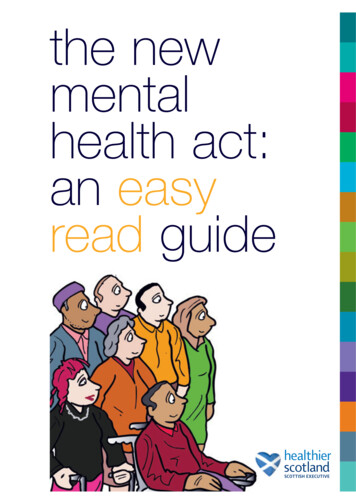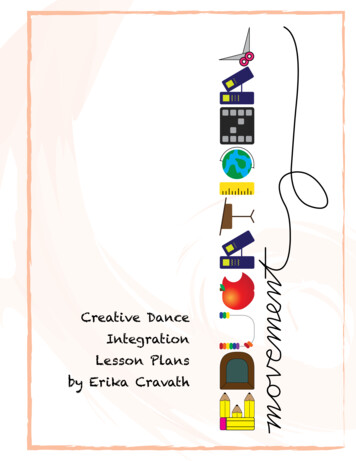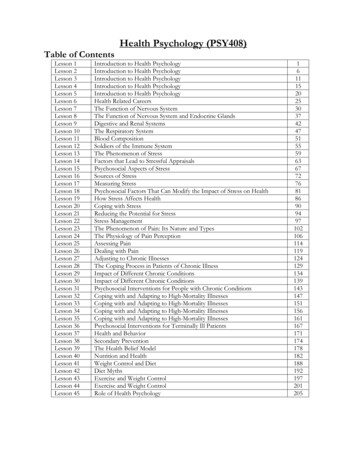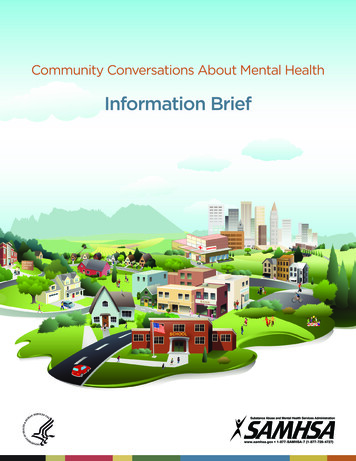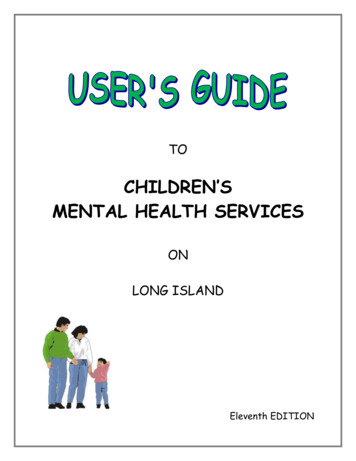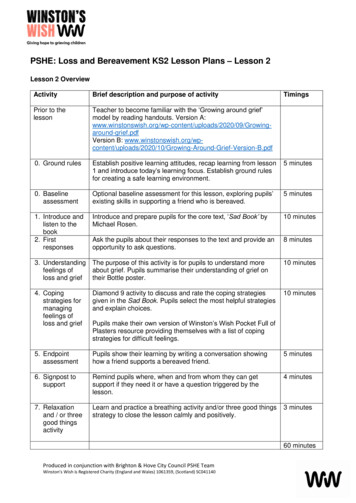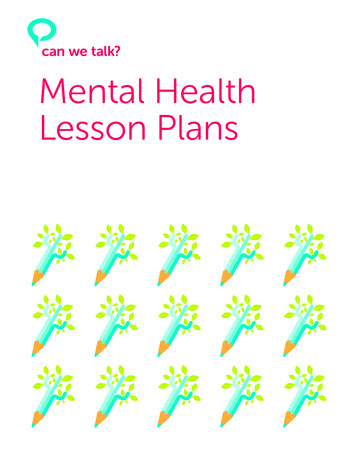
Transcription
Mental HealthLesson Plans
The Stigma ofMental IllnessThe Mental Health Commission of Canada (MHCC) reports that “manypeople living with mental illness say the stigma they face is often worsethan the illness itself.”In the context of these lessons, the US Substance Abuse and Mental HealthServices Agency (SAMHSA) defines stigma as “a cluster of negative attitudesand beliefs that motivates the general public to fear, reject, avoid and discriminate against people with mental illness” (SAMHSA 2004). The MHCCreports that one of the most substantial ways that this stigma affects peopleis that 60% of people with a mental illness won’t seek out the help theyneed due to the stigma associated with being labelled mentally ill.As educators, we have the ability to work towards the elimination of stigmaand discrimination by teaching the new generation that people with a mental illness are not to be feared, judged, avoided or discriminated against.Mental illness and mental health are gaining more traction in our collectiveconsciousness, and we can further that cause by bringing the discussioninto our classrooms. These lesson plans, in partnership with our Creating aCompassionate Classroom booklet, were created as resources to do just that.60% of people with a mental illnesswon’t seek out the help they need dueto the stigma associated with beinglabelled mentally ill.
Senior and Junior HighLesson Plan: StigmaThis lesson plan is adapted from the Mental Health and High SchoolCurriculum Guide from the Canadian Mental Health Association, availableonline at www.cmha.ca/highschoolcurriculum.Learning ObjectivesThe student willunderstand the stigma surrounding mental health problems, and theimpact of stigma and discrimination on help-seeking behaviour,be aware of the myths and the realities of mental illness,consider attitudes about mental illness andexhibit a realistic and positive understanding of mental illness.ActivitiesActivity 1: Defining StigmaActivity 2: Exploring Attitudes—SurveyActivity 3: Reducing Stigma—What Works?MaterialsActivity 1 Handout—Defining Stigma (one per student)Activity 2 Survey—Personal Attitudes Survey (one per student)Activity 2 Resource—Personal Attitudes Survey: Best Answers(teacher copy)Activity 3 Handout—Reducing Stigma—What Works? (one per student)
Activity 1: Defining Stigma (10 minutes)1. Ask students if they know what the word “stigma” means.2. Hand out Activity 1 Handout—Defining Stigma.3. Lead a whole-class discussion of the definition of “stigma,” and the relationship between stigma, stereotyping and discrimination.Questions to Guide DiscussionWhat are some of the negative things you have heard about people withmental illness? (Responses may include things like a link to violence, etc.)What are some of the positive things you have heard about mental illness? (Responses may include things like a link to creativity.) While thismay be seen as positive, remind students that generalizing can also be aform of stereotyping.Why do you think people with mental illness are stigmatized? (Possibleanswers include “They are seen as being different” and “People don’treally know the facts about mental illness.”)Can you think of any other health conditions or social issues that havebeen stigmatized throughout history? (Possible answers include same-sexrelationships, leprosy, AIDS, unwed motherhood, divorce.)What factors have contributed to changing public attitudes about someof these conditions or issues? (Possible answers include education, publicpolicy, open dialogue, scientific research, changing social mores.)What do you think influences perceptions about mental illness? (Possibleanswers include the media, films, news, newspaper headlines and storiesthat associate people with mental illness with violence, the fact thatpeople with mental illness sometimes behave differently and people areafraid of what they don’t understand.)How do you think stigma affects the lives of people with mental illness?(Possible answers include people deciding not to get help and treatmenteven though they would benefit from it, unhappiness, inability to get ajob or find housing, losing their friends, stress on the whole family.)
Activity 2: Examining Attitudes(15 minutes)1. Hand out Activity 2 Survey—Personal Attitudes Survey.2. Have students complete the personal attitudes survey individually.3. Using a show of hands, compile the results of the survey on the board.Have students record the class results on their handout.4. Ask students to share some general observations about the group’sresults. For example, only half the people surveyed agreed that theywould have someone with a mental illness as a close friend; most peoplebelieve that medication for life is the best treatment.5. Review the results of the class survey by comparing the results with theActivity 2 Resource—Personal Attitudes Survey: Best Answers. Facilitatea classwide discussion about the survey results, highlighting items thatmay be surprising to the group.Encourage students toapply the strategies forreducing stigma in theschool, at home and inthe community.Activity 3: Reducing Stigma (5 minutes)1. Hand out Activity 3 Handout—Reducing Stigma—What Works?2. Encourage students to apply the strategies for reducing stigma in theschool, at home and in the community.3. Remind students that things have improved since the days of the “looney bin”; however, there are still many examples of people living withmental illness being portrayed as violent and ridiculed in the mediaand popular culture. Have students think about topical stories from thenews, movies and TV shows.
Activity 1 HandoutDefining StigmaThe following are definitions of “stigma” taken from different sources anddifferent historical periods.“A mark or sign of disgrace or discredit; a visible sign or characteristic ofdisease.”The Concise Oxford Dictionary, 1990“An attribute which is deeply discrediting.”Erving Goffman, Stigma: Notes on the Management of Spoiled Identity, 1963“A distinguishing mark or characteristic of a bad or objectionable kind; asign of some specific disorder, as hysteria; a mark made upon the skin byburning with a hot iron, as a token of infamy or subjection; a brand; a markof disgrace or infamy; a sign of severe censure or condemnation, regardedas impressed on a person or thing.”The Shorter Oxford Dictionary, Fourth Edition, 1993Stigma is not just a matter ofusing the wrong word or action.Stigma is about disrespect.The Stigma of Mental Illness“Stigma refers to a cluster of negative attitudes and beliefs that motivate thegeneral public to fear, reject, avoid and discriminate against people withmental illnesses. Stigma is not just a matter of using the wrong word oraction. Stigma is about disrespect. It is the use of negative labels to identifya person living with mental illness. Stigma is a barrier. Fear of stigma andthe resulting discrimination discourages individuals and their families fromgetting the help they need.”SAMHSA, School Materials for a Mental Health Friendly Classroom, 2004
Terms Related to StigmaStereotype“A person or thing that conforms to an unjustlyfixed impression or attitude.”Stereotypes are attitudes about a group of people(e.g., “All people with mental illness are dangerous.”).Prejudice“a preconceived opinion”Prejudice is agreeing with the stereotypes(e.g., “I think people with mental illness are dangerous.”).Discrimination“unfavourable treatment based on prejudice”Discrimination is the behaviour that results: “I don’t want peoplewith mental illness around me; therefore, I discriminate against themby not hiring them, not being friends with them, etc.”The Concise Oxford Dictionary, 1996
?Activity 2 SurveyPersonal Attitudes SurveyCheck the most appropriate answer1People should work out theirown mental health problems.Agree6DisagreeAdults are more likelythan teenagers to have amental illness.Not sure2 Once you have a mentalillness, you have it for life.Agree7You can tell by looking atpeople whether they havea mental illness.Not sure45Females are more likely tohave a mental illness thanare males.Medication is the besttreatment for mental illness.People with a mentalillness are generally violentand dangerous.AgreeDisagreeNot sureDisagree3AgreeAgreeDisagreeNot sure8People with a mental illnessare generally shy and quiet.AgreeDisagreeDisagreeNot sureNot sureAgree9Mental illness only happensto certain kinds of people.AgreeDisagreeDisagreeNot sureNot sureAgree10 Most people will never beaffected by mental illness.AgreeDisagreeDisagreeNot sureNot sure
Activity 2 ResourcePersonal Attitudes Survey: Best Answers1. People should work out their own mental health problems.Not true. When people have a physical health concern, they generallytake some action and often go to the doctor or seek some other kindof help for their problem. Mental illness is associated with changes inbrain functioning and usually requires professional assistance. Becauseof the stigma surrounding mental illness, many people are reluctantto seek help.2. Once you have a mental illness, you have it for life.While it’s true that most mental illnesses are lifelong, they are oftenepisodic, which means that the symptoms are not always present. Justlike people who live with chronic physical illnesses like arthritis andasthma, people with mental illnesses can, when the illness is managed,live positive and productive lives.3. Females are more likely to have a mental illness than are males.Men and women are equally affected by mental illness in general, butwomen may experience higher rates of specific illnesses such as eatingdisorders and depression. Men have higher rates for some disorders suchas alcoholism and ADHD. Some illnesses are relatively equally shared bymen and women, like bipolar disorder.It may seem that women are more likely to have a mental illness thanmen, but this may be because women are more likely to seek help formental and emotional difficulties and to share their concerns withfriends than are men.4. Medication is the best treatment for mental illness.Medication can be a very effective part of managing a mental illness,but it is by no means the only type of treatment or support that helpspeople recover. A wide range of appropriate interventions, includingmedication, counselling, social and recreational groups, self-help, holistic health, religious support, hospital care, exercise and nutrition areoptions for helping people recover and stay well. The best approach is tohave a combination of strategies that have been proven to be effective.
5. People with a mental illness are generally violent and dangerous.People with mental illness are generally not more violent than therest of the population. Mental illness plays no part in the majority ofviolent crimes committed in our society. In fact, a person with a mentalillness is more likely to be a victim of violence than the perpetrator.The assumption that any and every mental illness carries with it analmost certain potential for violence has been proven wrong in manystudies. Often, it is the misrepresentation by the media that leadsto this false belief.6. Adults are more likely than teenagers to have a mental illness.Some illnesses are first diagnosed in childhood but many more beginto appear during the late teenage years and into early adulthood.7. You can tell by looking at people whether they have a mental illness.Sometimes if a person is experiencing symptoms of their mental illness,how they are feeling, thinking and behaving may be different from whatis normal for them, but generally, you cannot tell if a person has a mental illness based on his or her appearance8. People with a mental illness are generally shy and quiet.There is no strong causal relationship between personality characteristics and a tendency to develop mental illness. Some mental disorders,however, such as depression, anxiety and schizophrenia can lead peopleto avoid or limit social contact.9. Mental illness only happens to certain kinds of people.This is incorrect; mental illness can happen to anyone.10. Most people will never be affected by mental illness.The statistic in Canada is that one in five people will experience amental illness at some point in their life. When thought of in thiscontext, everyone is affected by mental illness, either directly (byhaving a mental illness themselves) or indirectly (by knowingsomeone with a mental illness).
Activity 3 HandoutReducing Stigma—What Works?There is no simple or single strategy to eliminate the stigma associatedwith mental illness, but some positive steps can be taken. Remember theacronym “WALLS” to help reduce stigma.Watch your languageAsk questionsLearn moreListen to experiencesSpeak outMake sure you are not using language or commentsthat stigmatize people with mental illness.A lot can be learned by asking questions of a mental healthprofessional like a counsellor or doctor, or a person who haslived experience with a mental illness.Great resources are available online to help educate you ondifferent mental illnesses. Increased education means fewermisunderstandings and less stigma.Once you have learned a bit about mental illness, consider askingsomeone you know about their experience with mental illness.If you are considerate and respectful, they may be comfortablespeaking about their experiences. If you have lived experience,consider sharing your story with others.Help reduce stigma by speaking out when others stigmatizepeople with mental illnesses or spread misconceptions.
Youth Mental Health—Additional ResourcesWebsiteskidshelpphone.ca or commind.org.ukjack.orgPhone NumbersKids Help Phone: 1-800-668-6868Rural Distress Line: 1-800-232-7288Suicide Crisis Hotline: 1-800-448-3000Bullying Helpline: 1-888-456-2323Mental Health Helpline: 1-877-303-2642Child Abuse Hotline: 1-800-387-KIDS (5437)Addictions Helpline: 1-866-332-2322Health Link: 811
Senior and Junior HighLesson Plan: Mind TrackerOngoing ActivityThis activity is to raise students’ awareness of their emotional states andbring attention to unhealthy behaviour that may suggest the presence of amental illness or mental health problem. They are also tools students canuse to communicate their emotional state to others. If a student suspectsthey may have an anxiety disorder, tracking the frequency and severity oftheir emotions can help them communicate to a guardian or doctor whatthey are experiencing.Students are to fill out the Mind Tracker on their own a few times perday for at least two weeks. The Trackers are intended to be private and,generally, should not be reviewed by a teacher so that students will feelcomfortable being honest and truthful.Students are encouraged to note any strong moods they experience, howmuch sleep they are getting, how they are eating and how much they areexercising. Students should also note unhealthy behaviour like drug andalcohol use, self-harm and suicidal thoughts.Over time, some students may notice patterns beginning to emerge(less sleep irritability, etc.). These patterns can be reflected on as agroup or individually.Some unhealthy patterns should be mentioned to class as reasons forreaching out to a teacher, guardian, counsellor or other supports in yourschool or community. These include any thoughts of suicide and/or selfharm, alcohol and/or drug abuse, over or undereating, sleeping very littleor a lot, extreme energy/mood, as well as long-lasting irritability, sadness,anger or anxiety. These patterns may indicate a serious problem thatrequires attention from a mental health professional.
Mind TrackerThroughout the day, use the symbols to track how you are feeling, what youare doing and anything else that you are concerned about. If your moods,thoughts or behaviours are getting in the way of everyday life, take this trackerto an adult. If you reach out, things CAN change and you CAN feel better.SundayMondayTuesdayI felt.WednesdayThursdayHappyHyperHow much (many) did I.Drugszzz iseSHSelf HarmAngryCalmCCigarettesSThoughts ofsuicideFridaySaturdayOtherNeed to talk? There is ALWAYS someone you can talk to:Kids Help Phone 1-800-668-6868Suicide Crisis Hotline: 1-800-448-3000Rural Distress Line: 1-800-232-7288Bullying Helpline: 1-888-456-2323
Other ideas you canimplement in your classroomregarding mental illness:Senior high school projectExamine portrayals of mental illness in the media or in pop culture anddiscuss how they do or do not stigmatize mental illness and people withlived experience.Junior high projectHave students research facts about mental illness that reduce stigma andhave them create a poster to put up in the school (e.g. “one in five Canadians will experience a mental illness at some point in their lives”; “recoveryis a journey that starts with reaching out”; “stamp out stigma”).Elementary projectHave students research a famous/influential person they admire wholived/lives with a mental illness and share what they accomplished/have accomplished.Contact your local CMHAMany organizations offer education programs for schools on the topic ofmental illness.
StressWhether it is neglecting our diet, taking on more than we are able to do,feeling irritable and anxious, having difficulty making decisions and evenexperiencing stomach upset and increased heart rate, we all find ourselvesfalling victim to unmanaged stress. These experiences are an extension ofthe fight or flight response—an adaptive feature of our bodies that helpsus deal with a threat. While being fueled by adrenaline and having anincreased heart and breathing rate, and other ways that our body becomesphysically ready, are very good in the short term for threats to our immediate physical danger, a prolonged and unmanaged response can lead tolong-term health repercussions. Part of dealing with stress and anxietyis the ability to recognize stress and implement strategies to deal with itbefore it becomes an overwhelming problem.
Senior High School Lesson Plan:Stress ManagementThis lesson plan is adapted from the presentation Youth Stress available aspart of the education program from the Canadian Mental Health Association, Calgary Region. Many thanks to Kimberly Feist.Learning ObjectivesThe student willdemonstrate awareness of his or her own levels of stress;recognize that management of positive/negative stress can affect health,recognize that stressors affect individuals differently, and outline waysindividuals respond to stress anddevelop personal strategies for dealing with stress/change.ActivitiesActivity 1: Stress TestActivity 2: Effects of StressActivity 3: Coping with StressMaterialsActivity 1 Handout—Stress Test (one per student)Chart paper and felt pensActivity 2 Resource—Effects of Stress (teacher copy)Activity 3 Handout—Coping with Stress (one per student)
Activity 1: Stress Test (10 minutes)1. Hand out Activity 1 Handout—Stress Test.2. Instruct students to complete the stress test by choosing a numberbetween 1 and 4 to indicate how often they experience each symptom.1 Never or Seldom2 Sometimes3 Often4 AlwaysStudents can keep a running tally at the bottom of the survey if theydon’t want to record their responses beside the individual items.3. Have students add up the numbers on the stress test,then write the following scoring guide on the board:Under 20—Low Stress21 to 30—Medium Stress31 and up—High Stress 124. Let students know thatstress is a normal reaction to the demands of life;when your brain perceives a threat, your body releases aburst of hormones to fuel your fight/flight/freeze response; andwhen the threat is gone, your body returns to normal.
Activity 2: Effects of Stress (15 minutes)1. Separate students into groups of three to five and ask them to brieflydiscuss some of the situations that make them experience stress. Allowthem three to four minutes to discuss.2. Ask the students to think about how and what they feel when they arefeeling stress.3. Have the students brainstorm and list on the chart paper differenteffects that they feel when they are stressed. Encourage them to thinkabout the following types of symptoms:Emotional (feelings)PhysicalMental (thoughts)4. Allow the groups four to five minutes to compile a list.5. Ask one member of each group to share their list of effects of stress andtalk about the different symptoms that come up commonly.6. Share any items from Activity 2 Resource—Effects of Stress that havenot been mentioned.Activity 3:Coping with Stress(5 minutes)1. Hand out Activity 3 Handout—Coping with Stress.2. Inform students that there arehealthy and unhealthy ways ofdealing with stress. The healthy ways help to reduce stress and relievesymptoms. Unhealthy ways of dealing with stress actually mask thesymptoms and causes of stress, may introduce new stressors and mayincrease the effects of stress in the future.3. Have students think about how they manage their own stress and howthey can incorporate healthy stress management into their lives.
Activity 1 HandoutStress TestRate each of thefollowing statementson a scale of 1 to 41 I have problems falling asleep or staying asleep.1 Never or Seldom2 I am uptight and cannot seem to relax.2 Sometimes3 I get angry if things do not go my way.3 Often4 Always4 I have difficulty concentrating.5 I have a hard time finding fun things to do.6 I feel tired during the day.7 I worry a lot about things going on in my life.8 I have had health problems becauseI work too hard.9 I use alcohol, cigarettes, caffeine or drugsto cope with stress.10 I laugh or smile less than I used to.11 I feel sad or disappointed often.12 I like to be in control.13 I don’t have enough time for all the thingsin my life.14 I have a habit of clenching my fists, cracking myknuckles, twirling my hair or tapping my fingers.Total
Activity 2 ResourceEffects of StressFight or FlightRelaxed StateHeart rateHeart ratePulsePulseBlood pressureBlood pressureMuscle contraction/tensionMuscle contraction/tensionShallow chest breathingDeep abdominal breathingBlood vessel sizeBlood vessel sizeDigestive actionDigestive actionBody temperatureBody le breathingExaggerating thingsNervousTrouble sleepingHaving bad thoughtsAnxiousStomach achesWorriedDizzinessHaving too muchto think aboutFrustratedEating more or aking outAches and painsOut of controlTension in musclesAngryPanicChest painsSusceptibility to physicalor mental illnessCan’t make a decisionOverthinkingNegative thinkingCan’t concentrateBlanking out
Activity 3 HandoutCoping with StressHealthy StrategiesGet plenty of restWatch a movieSet time for yourselfSpend time with a petFavourite childhood activityTake a bath or showerBreathing exercisesFocus on the good thingsExerciseUse a positive affirmationWork outWatch a funny videoPlay video gamesSet realistic expectationsListen to musicAsk for helpEat healthy foodLeave the situationDrink waterManage your timeTalk to friendsBe organizedMeditateSpend time with othersUnhealthy StrategiesDrugs or alcoholUnhealthy foodCaffeineSmokingVentingBottling up your emotionsPhysical violenceTaking it out on othersNot being able to say no
Youth Mental Health—Additional ResourcesWebsiteskidshelpphone.ca or commind.org.ukjack.orgPhone NumbersKids Help Phone: 1-800-668-6868Rural Distress Line: 1-800-232-7288Suicide Crisis Hotline: 1-800-448-3000Bullying Helpline: 1-888-456-2323Mental Health Helpline: 1-877-303-2642Child Abuse Hotline: 1-800-387-KIDS (5437)Addictions Helpline: 1-866-332-2322Health Link: 811
Junior High Lesson Plan: StressManagement Skills BingoOver the course of a week, have students mark off the tasks on the bingosheet. You can also have parents initial that the student completed the task.Completed sheets earn points for a team. The winning team gets to choosetheir favourite stress management technique to do as a class.
Stress Management BingoDuring the week, try these stress management tips. They can help you totake a break from your stress, help you stay organized and solve your problems, and also help you to feel better.BINGOSlept/restedfor 9 hours.Did homeworkas soon as Igot home.Made a list ofthings I neededto do.Foundsomething thatmade me laughwhen I wasupset.Listened tosome music whenI felt stressed.Exercised for30 minutesthree times inone week.Talked tosomeone aboutsomething thatwas botheringme.Wanted toprocrastinate, butdid somethingimportantinstead.Asked for helpwith a problem.Tried deepbreathing,meditation.Chose a healthysnack instead ofjunk food.Spent 30 minutesor more relaxingoutside or withan animal.Watchedmy favourite TV/Netflix show!Stretched mymuscles ordid yoga.Read a bookor comic for30 minutesor more.Wrote in a journalabout my day.Did my favouritehobby.Started withthe hardesttask first.Made a schedule(includingrelaxation time).Brainstormedways to solve aproblem.Spent 30minutes learningsomething new.Said a positiveaffirmation tomyself when Iwas stressed.Said “no” to anoptional requestso I could havetime for myself.Did somethingcreative.Spent time with afriend/loved one.
Elementary Lesson Plan:Resiliency BuildingThe goal of this activity is to improve self-esteem, raise awareness of personal skills and strengths and build class cohesion.The goal of this activityis to improve self-esteem,raise awareness ofpersonal skills andstrengths and buildclass cohesion.Student sit in a circle and the teacher draws a student’s name out of a hat.The name is said and students are given one minute to think of somethingthey want to recognize about that person. The activity is designed to pointout strengths and skills verses beauty or popularity, so comments like “sheis pretty” or “I like him” should be discouraged in favour of things like “shealways plays fair,” “he helps tidy the class,” “he is helpful to others,” “she isgood at math” etc.For younger grades, instead of recognizing a strength or skill, students cantake turns thanking the individual for something, for example, “thanks forhelping me clean up,” “thanks for being a good friend,” “thanks for playingwith me at recess,” etc.Once each student has had a chance to say something to the person, thestudent can thank the class for the recognition, and then the teacher canchose a new name and the process repeats.Two or three names can be chosen per day or once per week until all students have had a chance to hear nice things said about them. Then all thenames are put back into the hat and the cycle repeats.
Self-TalkEmotional responses to various situations depend on how we think aboutthe specific situation. What we think will influence how we feel. Even ifwe cannot change the situation, we can change the way we think about itand therefore the way we feel and act. Our inner voice can be both an allyand a fearsome enemy. This voice is often referred to as negative self-talkand positive self-talk. It is this self-talk (or interior dialogue) that guidesour feelings and behaviours. Discovering how to identify our thinking andchange our thoughts is a crucial step in dealing with stress and difficultfeelings. At times we have great difficulty silencing the negative voice. Inthis lesson, we will practise changing our inner voice from negative to positive self-talk to help deal with difficult feelings.Senior and Junior High SchoolLesson Plan: Negative Self-TalkSelf-talk—the messages we send to ourselves—is extremely influential toour mood, motivation and mental health. Unfortunately, self-talk can beso automatic that it seems like it is not even there. By learning to recognizenegative self-talk—the unhelpful thinking styles that affect us in negativeways—we can challenge and change these messages and the resulting feelings we have.
Activity 1: The Big ‘R’ —Recognizing negative self-talkTake a look at these unhelpful thinking styles. Fill in the two columnslabelled “Activity 1” with an example from your life and the related feelingsyou had when you had the thoughts.It can be hard to spot negative self-talk. Try thinking of recent eventsthat have caused you to feel sad, anxious or frustrated and then recall thethoughts you were having.1 Jumping to conclusions:when we assume what others are thinking or whenwe make predictions about the future.Jumping toconclusionsFeelingsMy friend waslate meeting withme. He must notlike me enough tobe on time.He will probablystop hanging outwith me.Hurt, lonelyActivity 1:Personal exampleActivity 1:Feelings I hadActivity 2:“CC”2 Personalisation:when we blame ourselves for things we have little or no control over.PersonalisationFeelingsThe bus cameearly and so Imissed it! Ishould haveknown it would.Stupid,angry atmyselfActivity 1:Personal exampleActivity 1:Feelings I hadActivity 2:“CC”
3 Catastrophizing:when we think of a situation as the worst it could possibly be.CatastrophizingFeelingsI got only a B onmy test. I am goingto fail this class.Upset,discouragedActivity 1:Personal exampleActivity 1:Feelings I hadActivity 2:“CC”4 Shoulding:when we place unrealistic expectations on ourselves.ShouldingFeelingsI should run everymorning becauseI should lose a lotof weight.Feel like afailure whenI can’t liveup to thisexpectationActivity 1:Personal exampleActivity 1:Feelings I hadActivity 2:“CC”5 Overgeneralisation:when we take one example and place it on all presentand past experiences.OvergeneralisationFeelingsMy teacher alwaysyells at me.Angry,frustratedActivity 1:Personal exampleActivity 1:Feelings I hadActivity 2:“CC”
6 Labelling:when we label ourselves or others because of a specific circumstanc
The Shorter Oxford Dictionary, Fourth Edition, 1993 The Stigma of Mental Illness “Stigma refers to a cluster of negative attitudes and beliefs that motivate the general public to fear, reject, avoid and discriminate against people with mental illnesses. Stigma is not just a matter of us



